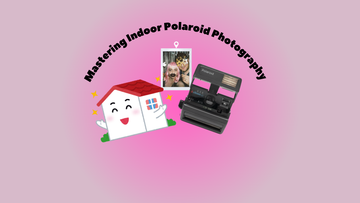Mastering Indoor Polaroid Photography: Settings, Flash Tips, and Avoiding Blurry, Dark Shots
por Дашка Шипунова en Jul 29, 2025

Capturing stunning indoor Polaroid photos can be a bit tricky, but with the right techniques and settings, you can elevate your instant photography game to new heights. In this comprehensive guide, we'll dive deep into the world of Polaroid 600 cameras and share our best tips and tricks for nailing your indoor shots every time.
Understanding Your Polaroid 600 Camera
The Polaroid 600 series cameras are iconic instant film cameras that have been beloved by photographers for decades. These cameras are known for their simplicity, portability, and the unique, nostalgic look and feel of their images. However, when it comes to shooting indoors, the Polaroid 600 can present some unique challenges that you'll need to overcome.
One of the key limitations of the Polaroid 600 is its low-light performance. Unlike modern digital cameras, the Polaroid 600 is not as capable in dimly lit environments. This means that you'll often need to rely on the camera's built-in flash to get properly exposed shots indoors.
Another important factor to consider is the camera's fixed focus lens. While this simplifies the shooting process, it also means that you'll need to be mindful of your subject's distance from the camera to ensure sharp, in-focus results.
Mastering the Polaroid 600 Flash
The Polaroid 600's built-in flash is a crucial tool for indoor photography, but it's important to use it correctly to get the best results. Here are some tips for using the flash effectively:
- Position your subject properly: When using the flash, it's best to place your subject about 4 feet (1.2 meters) away from the camera and in front of a light-colored background, such as a white wall. This will help to ensure even, well-lit results.
- Avoid direct flash: While the flash can be a lifesaver in low-light situations, it's important to avoid pointing it directly at your subject. This can result in harsh, unflattering shadows and highlights. Instead, try to angle the flash slightly to the side or above your subject.
- Experiment with flash intensity: Many Polaroid 600 cameras allow you to adjust the flash intensity, either through a dedicated button or by pressing the shutter button halfway. Try different settings to find the perfect balance of light for your scene.
- Use the flash shutter button: If your Polaroid 600 camera has a dedicated flash shutter button, be sure to use it. This will ensure that the flash fires every time you take a shot, helping to prevent underexposed images.
Shooting Without the Flash
While the flash can be a powerful tool for indoor Polaroid photography, there may be times when you want to avoid using it. Perhaps you're trying to capture a moody, natural-light-inspired image, or you're worried about the flash overpowering your subject. In these cases, you'll need to rely on the camera's low-light capabilities, which can be a bit more challenging.
One key tip for shooting without the flash is to position your subject near a window or other natural light source. This will help to provide enough illumination to properly expose your image. Keep in mind, however, that the Polaroid 600's fixed focus lens may struggle to keep your subject sharp in these low-light conditions, so you may need to experiment with different distances and compositions.
Another option is to use a tripod or other stabilizing device to help reduce camera shake and blur. This can be especially helpful when shooting in dimly lit environments with longer exposure times.
Avoiding Blurry, Dark Photos
One of the most common challenges with indoor Polaroid photography is dealing with blurry, underexposed images. Here are some tips to help you avoid these issues:
- Use the flash: As we mentioned earlier, the flash is a crucial tool for indoor Polaroid photography. By using the flash, you can ensure that your subject is properly illuminated and reduce the risk of blurry, dark images.
- Stabilize your camera: Camera shake is a common culprit of blurry Polaroid photos, especially in low-light conditions. Use a tripod, lean your camera against a stable surface, or brace it against your body to help keep it steady.
- Adjust your subject distance: Remember that the Polaroid 600's fixed focus lens has a limited range, so be sure to position your subject within the camera's optimal focus distance (around 4 feet or 1.2 meters).
- Experiment with exposure compensation: Many Polaroid 600 cameras allow you to adjust the exposure compensation, which can help to prevent underexposed or overexposed images. Try different settings to find the perfect balance for your scene.
Shooting Polaroid Indoors: Tips and Techniques
Now that we've covered the basics of indoor Polaroid photography, let's dive into some more advanced tips and techniques to help you take your images to the next level:
Capturing Portraits
Portraits are a classic Polaroid subject, and with the right approach, you can create stunning, intimate images. When shooting portraits indoors, be sure to position your subject in front of a light-colored background, such as a white wall, and use the flash to ensure even, flattering lighting.
You can also experiment with different angles and compositions to add visual interest to your portraits. Try shooting from above, below, or at eye level to create unique perspectives.
Capturing Moody, Natural-Light-Inspired Shots
While the flash can be a powerful tool, there may be times when you want to capture a more moody, natural-light-inspired image. To do this, position your subject near a window or other natural light source and experiment with different exposure settings to find the perfect balance of light and shadow.
Keep in mind that these low-light shots may require longer exposure times, so be sure to use a tripod or other stabilizing device to prevent camera shake and blur.
Capturing Still Life and Product Shots
Polaroid cameras are also well-suited for capturing still life and product shots, especially indoors. When shooting these types of images, be sure to pay close attention to your composition and lighting. Experiment with different angles, props, and backgrounds to create visually interesting and engaging images.
As with portraits, you can use the flash to ensure even, well-lit results, or you can opt for a more natural, moody look by positioning your subject near a window or other light source.
Capturing Motion and Action
While the Polaroid 600 may not be the first camera that comes to mind for capturing motion and action, it can still be a fun and creative tool for these types of shots. When shooting indoor action, be sure to use the flash to help freeze the motion and prevent blur.
You can also experiment with panning techniques, where you follow the movement of your subject with the camera, to create a sense of motion and dynamism in your images.
Conclusion
Mastering indoor Polaroid photography takes practice and experimentation, but with the right techniques and settings, you can capture stunning, one-of-a-kind images that showcase the unique charm and character of the Polaroid 600 camera.
Remember to always use the flash when shooting indoors, position your subject properly, and experiment with different exposure settings and compositions to find what works best for your scene. And don't be afraid to get creative – the Polaroid 600 is a versatile camera that can be used to capture a wide range of subjects and styles.
So, what are you waiting for? Grab your Polaroid 600 camera, head indoors, and start capturing the world around you in a whole new way. Happy shooting!
For more tips and resources on using your Polaroid 600 camera, be sure to check out our website and our Amazon store.




